Student Winner
Tools Award
Core77 Design Awards 2024
CAPTR - Spatial Crime Scene Investigation
Crime scene investigators use a variety of tools to capture and document crime scenes and potential evidence. These tools include cameras, measuring devices, powders, different light sources and casting materials. Creating a rich collection of documentation material is crucial for reconstructing the course of events and presenting relevant information in court.
CAPTR is a spatial crime scene documentation system that provides professional crime scene investigators with a powerful tool that helps them to effectively document crime scenes using photos, videos, audio recordings and 3D-scans. The system consists of a wearable computing unit and a handheld scanning device. By embedding multiple layers of captured information in a 3D representation of the crime scene, professionals can digitally revisit the scene afterwards and create rich, immersive court presentations of the investigation results.
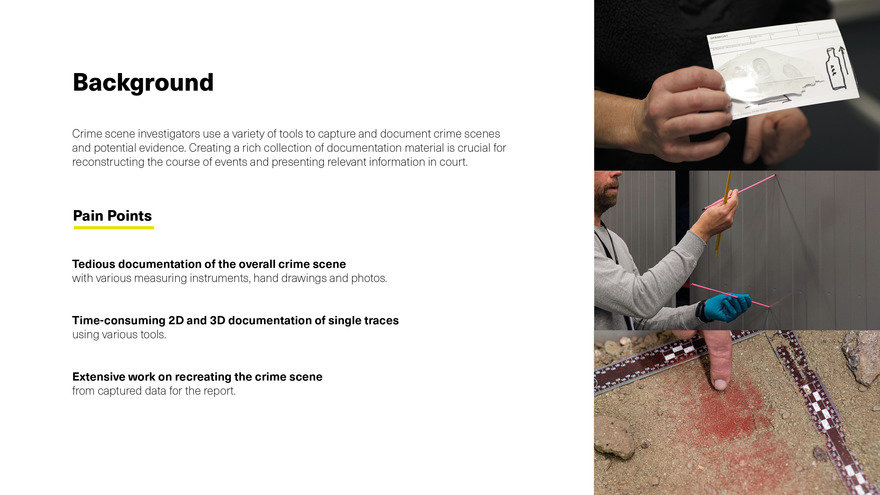
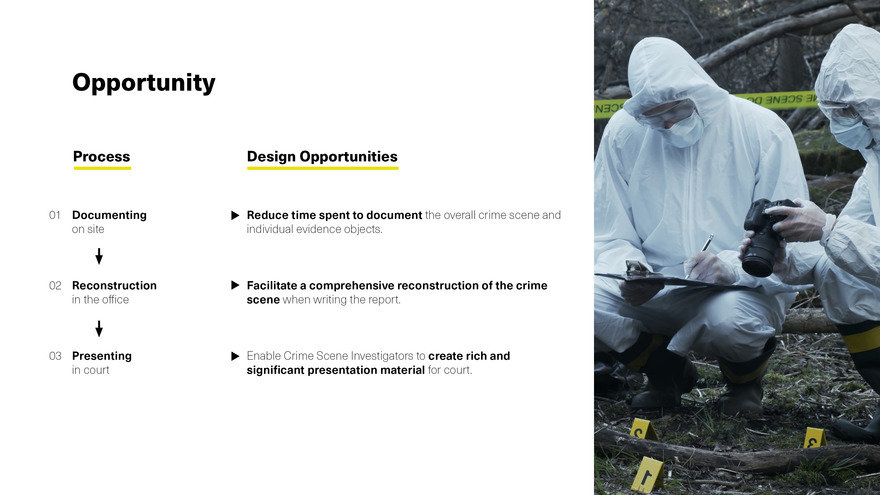
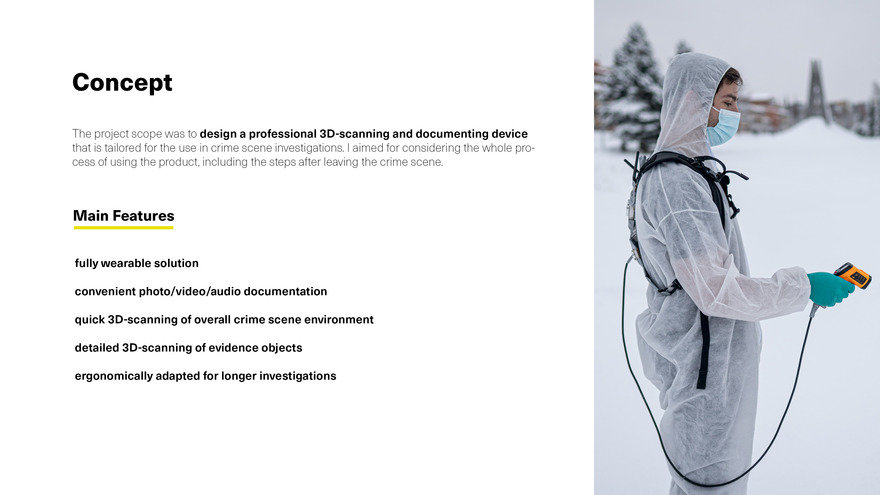
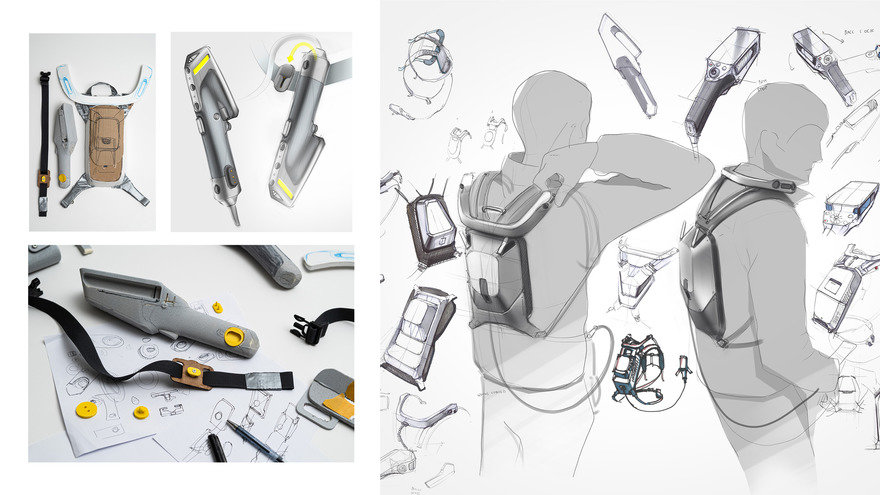
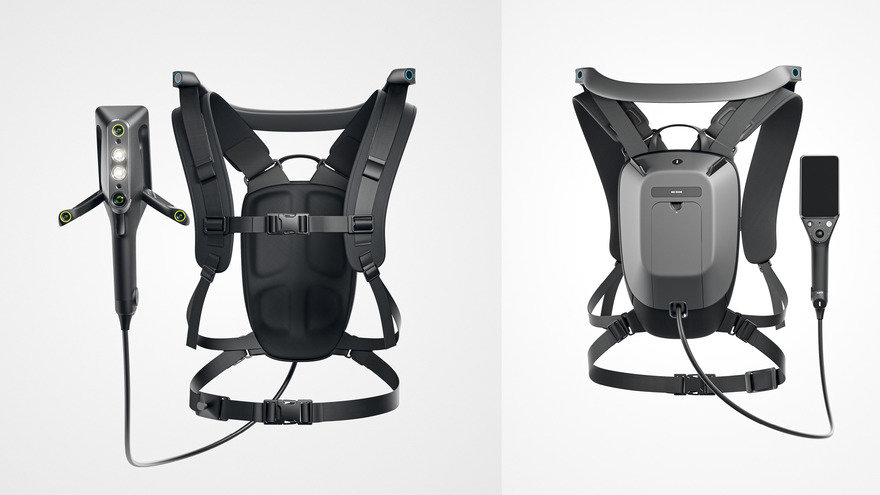

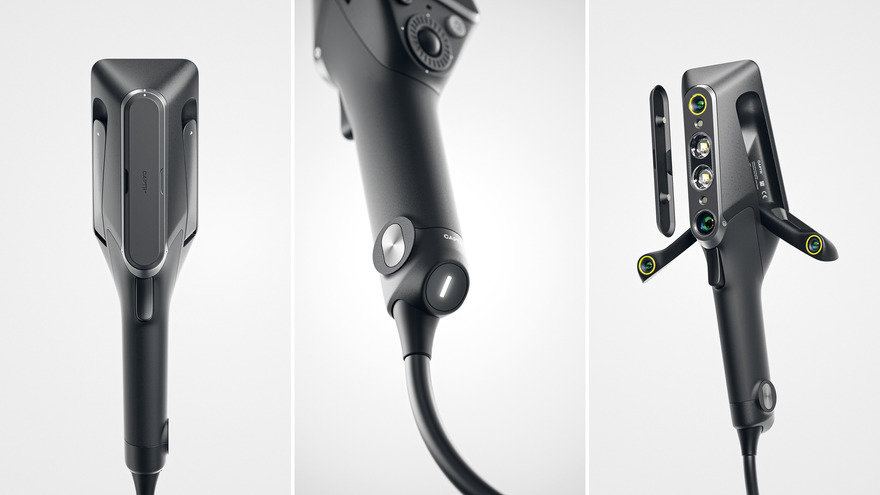
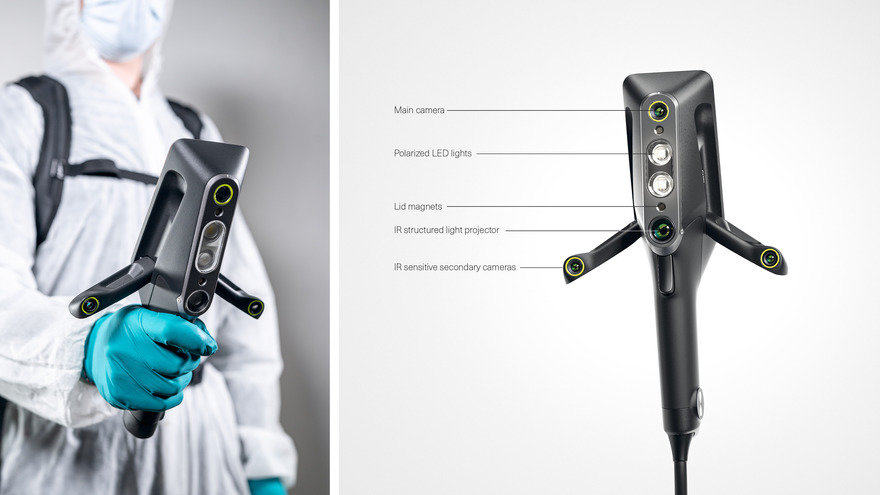
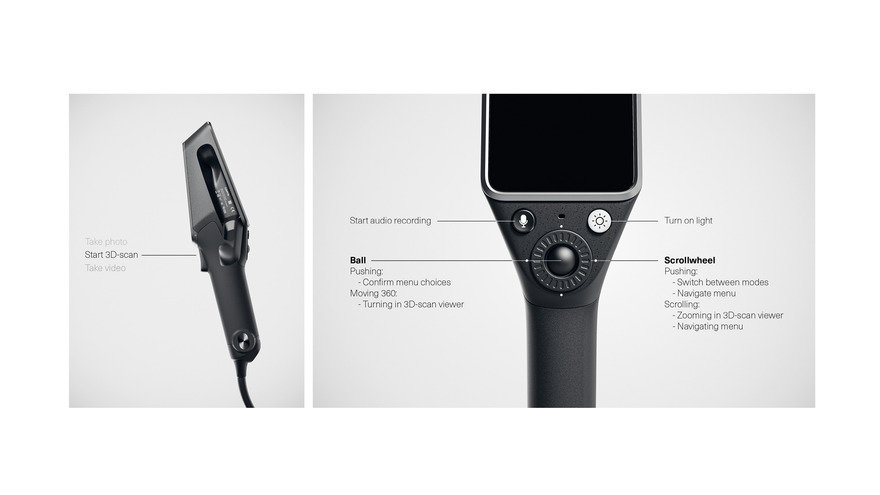
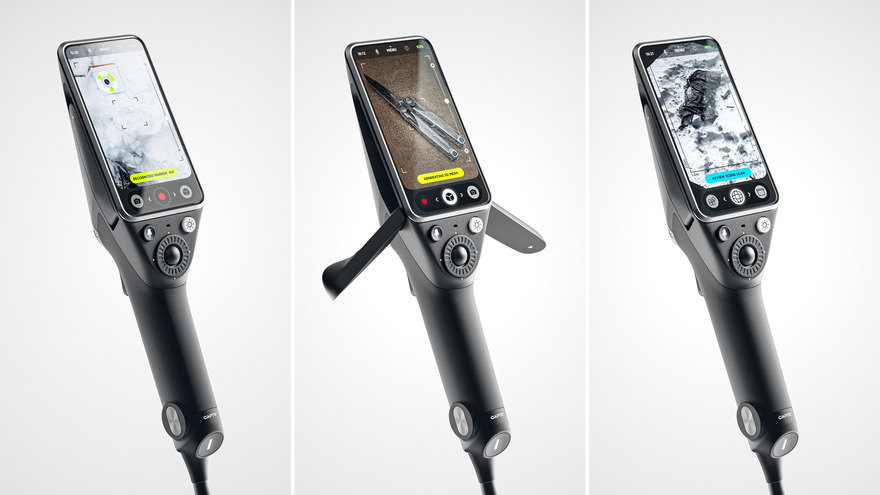

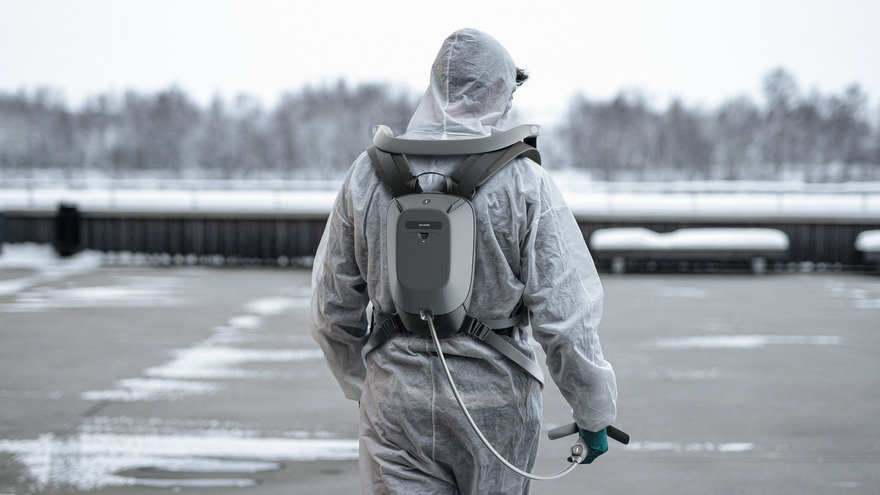
Background
The focus of this project lies on crime scene forensics and the professionals and tools involved in the process. Crime scene forensics is a specific field within the different disciplines of forensic science, and focuses on the investigation at the crime scene itself.
In Sweden, there are two units that are conducting crime scene investigations:
The Patrolling Police Officers and the Forensic Technicians.
Research
The research for this project was conducted in cooperation with the Police Education Unit of Umeå University and the Crime Scene Investigation Unit at Police Station Umeå. It consisted of three major parts: In our first field trip, we visited the Police Education Unit at Umeå University where we learned about the basic techniques of forensic investigations. For the second field trip we visited the Police station Umeå, where we had the chance to talk to two professional forensic technicians and get deeper insights into their work. After structuring all gathered information, we conducted further desktop research in groups and deepened our knowledge about recent developments within this field.
Insights
In my project, I wanted to focus on the forensic technicians. These are the main problems and pain points that were identified:
- many different parts and tools, which makes the process more complex than necessary
- extensive work on structuring all captured evidence and writing the investigation report
- time-consuming and messy capturing of fingerprints and small traces like tool marks using the Mikrosil method
- despite the advanced equipment, it is time-consuming to document evidence with the right lightning and correct scale (usually two people involved)
- getting back analysis results from the Swedish National Forensic Center often takes a lot of time and slows down the overall progress of the investigation
Opportunities
The documentation of evidence is currently done in various ways. Photography is used to document the overall crime scene constellation and the position as well as the appearance of the evidence itself. For evidence such as footprints, it is often necessary to take multiple photos with different light setups to capture the whole print. Additionally, a scale needs to be placed next to the print for an accurate reconstruction. Then, the different pictures have to be manually overlayed in digital software to generate an image that can eventually be used for the comparison with a shoe print database. Other techniques include using a coloured powder to make a print better visible, and to create a plaster casting of the print. For small traces like tool marks on a door lock, a 2-component mixture is applied to create a physical cast that is later analyzed and compared.
3D-scanning is a technology that is slowly finding its way into crime scene investigations. At the moment, it is mostly used for cases of big relevance, but there is a clear indication that its use is getting more widespread. The benefits of using 3D-scanning technologies in crime scene investigation are manifold.
Two of the biggest use areas are:
- Creating a digital overview of the crime scene that helps with reconstructing the crime and visualizing the relative position of different evidence found.
- Generating detailed, coloured and real-life scale 3D-models of evidence such as plastic footprints and fingerprints as well as toolmarks, weapons or victims' wounds.
The gathered data can be used in a variety of ways to visualize and analyze important features.
Project Goal
The project scope was to design a professional 3D-scanning and documenting device that is tailored for the use in crime scene investigations. I aimed for considering the whole process of using the product, including the steps after leaving the crime scene.
The most important problems to be solved were:
- Reduce the time spent on documenting the overall crime scene and individual evidence objects.
- Reduce the time spent on recreating the scene when writing the report.
- Enable crime scene investigators to create a detailed and accessible 3D digital version of the crime scene and certain evidence.
- Digitally "freeze" the crime scene on arrival.
Process
To get a better understanding of the process of using a 3D-scanning system in an investigation, I staged a crime scene outdoors. Then I reenacted securing and documenting the crime scene using rough mock-ups. This provided me with valuable insights and helped to further define the features of the product. At first I focused mostly on the backpack itself, how it could scan the environment without limiting or disturbing the forensic technician at work and how the combination with the handheld part of the system works. As the product is tailored for professional users, I planned on orientating on a form language that conveys robustness, precision and reliability. I continued to refine the design of the handheld part until it was ready to get user feedback.
Concept Validation
I had the chance to show my concepts to both an active Swedish forensic technician and a Swedish 3D-scanning specialist who works on the development of visualisation methods for the Swedish Police. Both approved the concept and the technical thoughts I had on the product. Furthermore, they gave me valuable insights into current developments in their field of profession. In consideration of the received feedback from tutors, the forensic technician and the 3D-scanning specialist, I continued developing the design. I went through multiple iterations on all important components of the system.
Final Design Concept
CAPTR is a spatial crime scene documentation system that provides professional crime scene investigators with a powerful tool that helps them to effectively document crime scenes using photos, videos, audio recordings and 3D-scans. The device consists of a wearable computing unit and a handheld scanning device. While the handheld device is made to document traces in detail, a combined LiDAR and camera system worn on the shoulders can be used to capture the surroundings automatically. All gathered information is then embedded in a digital 3D version of the crime scene and can be easily accessed. This allows the investigators to revisit the scene in 3D and create meaningful court presentations of the investigation results.
The backpack consists of a hard shell and a soft, flexible frame, which protects the components within the hard shell and makes the backpack more flexible and comfortable to wear. The hard shell contains all computing components, digital storage and the battery. The battery - which powers all components - is removable for charging. Integrated antennas help transmitting captured data to the cloud for backups and and further processing. Inbetween the hard shell bottom and the soft frame, there is an outlet for the power and data transmission cable that leads to the handheld part of the system.
Pressing the power button on the top part starts up the backpack. After picking up the backpack, a stiff bracket equipped with 3D-scanning sensors can be pulled up so that the sensors sit right on top of the forensic technicians shoulders. This way, the sensors have a 360° field of view and can therefore capture the whole environment. The process of the automatic scene scanning can be initialized by the operator using the interface of the handheld device. The shoulder part connects the sensors of the left and right side in a rigid way, which reduces processing effort. Connected through elastic straps, that contain extendable wires, the sensors on the shoulder part receive power and can send captured data directly to the processing unit.
The process of getting the handheld device ready for documentation is quick and simple. The user removes the lens cap, turns on the device and flaps out the arms.
The handheld device houses a system for near-infrared structured light scanning, which is a 3D-scanning technology suitable for creating detailed scans of objects under various light conditions. This includes a projector for generating infrared light patterns and three infrared sensitive cameras that capture the patterns projected on the subject. The main camera is also used for taking conventional photos and videos. Two powerful LEDs provide light in dark environments. Recessed lens cap magnets hold a lens protection cap that can be put on when not using the product. Manual controls help to use the most important functions of the device in a quick and reliable way. Optionally, the device can be operated via the touchscreen.
The interface always shows the current recording mode (photo/video/3D-scan) at the bottom of the screen. To make the operation more reliable and to avoid mistakes, the interface provides the user with information about ongoing processes.
An important feature of the hand unit is a holster that allows the user to quickly attack the device to the belt strap, which is part of the backpack. This allows the operator to have both hands free for navigating on the scene while the device can hang safely on the dedicated holster. When pressing the device against the pill-shaped holster pin in a horizontal position, the pill-shaped, spring-loaded plate is pushed in. Then, the device can be rotated down into a vertical, hanging position, locking the pin in its handle.
Core77 Design Awards 2024
- Apps & Platforms
- Branding & Identity
- Built Environment
- Commercial Equipment
- Consumer Technology
- Design for Social Impact
- Emerging Technologies
- Furniture & Lighting
- Gaming Accessories
- Health & Wellness
- Home & Living
- Interaction
- Lifestyle Accessories
- Packaging
- Robotics
- Speculative Design
- Sports & Outdoors
- Sustainability
- Tools
- Toys & Play
- Transportation
- Visual Communication